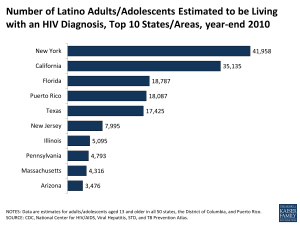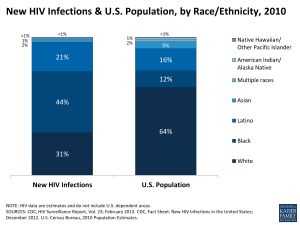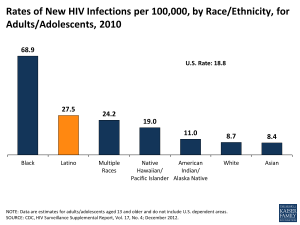Latinos and HIV/AIDS
Latinos in the United States continue to be impacted by HIV/AIDS, having higher rates of both new HIV infections and people living with HIV disease than their white counterparts.1,2,3,4 Latino youth and gay and bisexual men have been particularly affected, and the epidemic’s impact varies across the country. Moreover, a number of challenges contribute to the epidemic in Latino communities, including poverty, injection drug use, stigma and discrimination, limited access to health care, and language or cultural barriers in health care settings.5 As the largest and fastest growing ethnic minority group in the U.S., addressing HIV in the Latino community takes on increased importance in efforts to address the epidemic across the country.
Snapshot of the Epidemic
- Today, there are more than 1.1 million people living with HIV in the U.S., including more than 220,000 Latinos.4
- Latinos represented approximately 16% of the U.S. population6 but accounted for 21% of new HIV infections and 19% of people living with HIV disease in 2010.2,3,4 Latinos also accounted for 21% of new AIDS diagnoses in 2011 (AIDS being the most advanced form of HIV disease).1
- The rate of new HIV infections per 100,000 among Latino adults/adolescents was the 2nd highest of any racial/ethnic group in the U.S. in 2010 – over 3 times that of whites, but less than half that of Blacks.2
- Latinos accounted for nearly 1 in 5 deaths among people with an HIV diagnosis in 2010 (3,513, or 18%).1
Key Trends and Current Cases
- The number of new HIV infections among Latinos peaked in the late 1980s, has declined since then, and stood at 9,800 in 2010. Throughout the epidemic, the number of new HIV infections among Latinos has been lower than those among whites and Blacks.2,7
- HIV incidence and prevalence rates (which show the severity of impact after controlling for differences in population size) illustrate the impact on Latinos. Among people 13 years and older estimated to be newly infected with HIV in 2010, the incidence rate for Latinos was 3 times higher than for whites (27.5 compared to 8.7).2 Similarly, Latinos were more than twice as likely as whites to be living with HIV at the end of 2010 (rates of 579.3 and 223.0, respectively).4
- The number of Latinos living with an HIV diagnosis increased by 8% between 2008 and 2010, compared to a 7% increase among Blacks and a 5% increase among whites.1
- Latinos accounted for 18% of deaths among people with an HIV diagnosis in 2010, and the number of deaths among Latinos with an HIV diagnosis decreased by 3% between 2008 and 2010; deaths among Blacks also decreased (8%), and deaths among whites remained stable.1
- In 2010, the HIV death rate per 100,000 for Latinos was more than twice the rate for whites (rates of 2.2 and 1.1, respectively).8
Transmission
- HIV transmission patterns among Latino men vary from those of white men. Both groups are most likely to be infected through sex with other men, but heterosexual transmission accounts for a greater share of new diagnoses among Latino men than white men.1,2,9
- Latinas are somewhat more likely to have been infected through heterosexual transmission than white women, although this is the most common transmission route for both groups and for women overall. White women are more likely to have been infected through injection drug use than Latinas.1,2,9
Women and Young People
- Among women, Latinas accounted for 1,400, or 15%, of new HIV infections, and their HIV incidence rate was more than 4 times the rate for white women, but about one quarter of the rate for Black women, in 2010.2
- Latinas represented 14% of new HIV infections among all Latinos (men and women combined) in 2010, a share similar to white women (11%), but much lower than for Black women, who represented 29% of new HIV infections among Blacks.2
- Among women living with an HIV diagnosis at the end of 2010, 19% were Latinas, a similar share were white women (18%), and 60% were Black women.1
- In 2010, 20% of new HIV infections among youth ages 13-24 were Latino, a similar share were whites, and nearly 3 times as many (57%) were Blacks.2
- Newly infected Latino men and women are more likely to be younger than whites – 24% of new HIV infections among Latinos in 2010 were 13-24 year-olds, compared to 16% of new infections among whites.2
Gay and Bisexual Men
Among Latinos, men who have sex with men are heavily affected by HIV:
- In 2010, male-to-male sexual contact accounted for nearly 7 in 10 (68%) new HIV infections among Latinos overall and nearly 8 in 10 (79%) new infections among Latino men.2
- Newly infected Latino men who have sex with men are younger than their white counterparts, with those ages 13-24 accounting for 28% of new HIV infections among Latino men who have sex with men in 2010, compared to 16% among whites.2
- A study in 20 major U.S. cities found that 15% of Latino gay and bisexual men in the study were infected with HIV, compared to 30% of Black and 14% of white gay and bisexual men. Many of these men did not know they were infected.10

Number of Latino Adults/Adolescents Estimated to be Living with an HIV Diagnosis, Top 10 States/Areas, year-end 2010
Geography
Although HIV diagnoses among Latinos have been reported throughout the country, the impact of the epidemic is not uniformly distributed:
- HIV diagnoses among Latinos are clustered in a handful of states, with 10 states accounting for 86% of Latinos estimated to be living with an HIV diagnosis at the end of 2010. New York and California top the list. While the District of Columbia had far fewer Latinos living with an HIV diagnosis in 2010 (838), it had the highest rate of Latinos living with an HIV diagnosis at the end of 2010 (1,830.2 per 100,000); a rate more than 4 times the national rate for Latinos (432.4).11
- Ten large metropolitan areas accounted for 61% of Latinos living with an HIV diagnosis at the end of 2009. The New York, Los Angeles, and Miami metropolitan areas had the greatest numbers of Latinos living with an HIV diagnosis.12
- HIV diagnoses among Latinos also vary by place of birth. Among cases for which place of birth data was available, U.S.-born Latinos accounted for 48% of Latinos diagnosed with HIV in 2011, followed by Latinos born in Mexico (20%) and Puerto Rico (15%).1
HIV Testing and Access to Prevention & Care
- About half (53%) of Latinos ages 18-64 report ever having been tested for HIV. Latinos ages 18-64 are more likely than whites in the same age group to report having been tested for HIV in the last 12 months (30% compared to 14%).13
- Among those who are HIV positive, CDC data indicate that over a third of Latinos (36%) were tested for HIV late in their illness – that is, diagnosed with AIDS within one year of testing positive; by comparison, 31% of Blacks and 32% of whites were tested late.1
- Looking across the spectrum from HIV diagnosis to viral suppression – the point at which the virus is under control and a person can remain healthy and reduce the risk of transmission – reveals missed opportunities for reaching Latinos. While the majority of Latinos are diagnosed (80%) and linked to care (67%), far fewer remain in regular care (37%) and are prescribed antiretroviral therapy (33%). Only one quarter (26%) of Latinos are virally suppressed – a share higher than for Blacks (21% of whom are virally suppressed), but lower than the share among whites (30%).14
Concern About HIV/AIDS
- A recent survey found that Latinos express greater concern about HIV/AIDS than whites – 19% of Latinos name it as the most urgent health problem facing the nation today, compared with 7% of whites.13
- Among Latinos, 27% say they are personally very concerned about becoming infected with HIV, a proportion that has declined since the mid-1990s. One quarter of Latinos also express concern about an immediate family member becoming infected, compared with 45% of Blacks and 9% of whites.13
Endnotes
CDC. HIV Surveillance Report, Vol. 23; February 2013. HIV diagnosis data are estimates from all 50 states, the District of Columbia, and 6 U.S. dependent areas. Rates do not include U.S. dependent areas.
CDC. HIV Surveillance Supplemental Report, Vol. 17, No. 4; December 2012. Data are estimates and do not include U.S. dependent areas.
CDC. Fact Sheet: HIV in the United States; November 2013.
CDC. HIV Surveillance Supplemental Report, Vol. 18, No. 5; October 2013. Data are estimates and do not include U.S. dependent areas.
CDC. Fact Sheet: HIV among Hispanics/Latinos in the United States and Dependent Areas; November 2013.
U.S. Census Bureau. 2010 Population Estimates.
Hall HI et al. “Estimation of HIV Incidence in the United States.” JAMA, Vol. 300, No. 5; August 2008.
NCHS. Health, United States, 2012; May 2013.
CDC. Slide Set: HIV Surveillance by Race/Ethnicity (through 2011).
Wejnert C et al. “HIV Infection and Awareness among Men Who Have Sex with Men – 20 Cities, United States, 2008 and 2011.” PLoS ONE, Vol.8, No. 10; October 2013.
CDC. National Center for HIV/AIDS, Viral Hepatitis, STD, and TB Prevention Atlas. Data are estimates from all 50 states, the District of Columbia, and Puerto Rico. Rate is not available for Puerto Rico.
CDC. HIV Surveillance Supplemental Report, Vol. 18, No. 1; January 2013. Data are estimates from 46 states and Puerto Rico. Estimates are not available for all metropolitan statistical areas.
The Washington Post/KFF. 2012 Survey of Americans on HIV/AIDS; July 2012.
CDC. Fact Sheet: HIV in the United States: The Stages of Care; July 2012.


